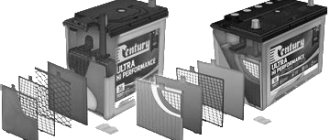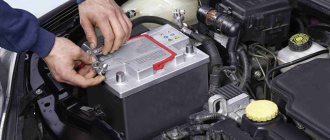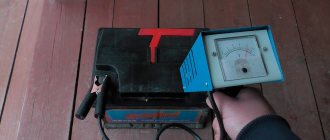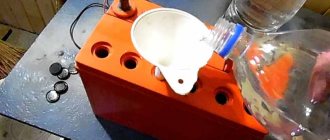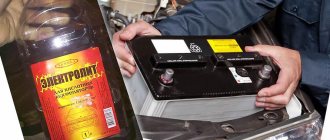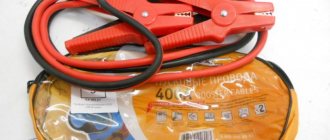Technological progress does not stand still
Just 10-15 years ago, car enthusiasts had to regularly service the battery (check the density of the electrolyte, top up with distilled water, and so on).
At the present stage, serviceable batteries are becoming a thing of the past. They have been replaced by more modern and reliable (according to the manufacturers) maintenance-free power supplies.
All that is required of car enthusiasts is to control the voltage level and charge in a timely manner. The only question is how to do this job correctly.
How to distinguish batteries
Now let’s talk about how you can distinguish a serviced car battery from a non-serviceable one. It's actually not that difficult to do. There are several characteristic signs that clearly show what type of power source you have in front of you.
Many have already realized the difference between them. Both serviced and maintenance-free car batteries perform identical functions and tasks. But they have their strengths and weaknesses.
If we talk about the difference between a maintenance-free battery and a conditional competitor in the form of a maintenance-free power source, then here we can focus on several points:
- Viewing peephole. Carefully inspect the surface of the battery case. If you see a peephole here, like on the front door, you have a maintenance-free power source. Although this is not the only difference between a serviced car battery and an unserviced one, many people pay attention to this point.
- Traffic jams. There may also be plugs on the top of the case, which, if necessary, can be easily unscrewed by hand or with a handy tool. Their presence indicates that this is a serviceable battery. Accordingly, it is not difficult to guess how to determine the maintenance-free type of battery. She won't have such traffic jams.
- Marking. If you know how to decipher the meaning of the markings on the battery, then literally in a minute you will understand from the inscriptions on the case which battery you are faced with.
- Documentation. Another way to find out whether your battery is serviceable or maintenance-free is to look at the documents. When purchasing a battery, the manufacturer and seller attach documents describing the battery, its characteristics, warranty card, etc. Here you can read everything about your battery, including its type.
The easiest way to determine the type of battery is by the first two signs. If in doubt, study the labeling and leaf through the documents.
What are the differences between serviced and maintenance-free batteries?
Today, all power sources can be divided into two types:
1. Serviced.
The first serviceable batteries were of the lead-calcium type. Their main advantage is the ability to work for two years without adding electrolyte.
But there was also a minus - a deep discharge turned out to be “deadly” for the battery. Just a few charge and discharge cycles, and the battery could be thrown into the trash.
At the end of the 90s, more modern ones appeared - lead-calcium products. Their feature is greater resistance to discharges and the absence of the need to add distilled water.
At the next stage, lead-acid batteries appeared (they are still used today).
The externally serviceable battery is a monoblock, which has several outlets with covers on the edges (for adding liquid).
Despite all its advantages (high capacity, long life, resistance to deep discharges), the battery required constant attention.
The occurrence of electrochemical reactions led to “burning out” of the electrolyte and the need to add distilled water.
In particular, the main problem with maintained power supplies is the presence of antimony on the down conductor.
The latter moves to the cathode through chemical reactions and helps reduce the voltage at the battery output.
The result is molecular decomposition, and then the active release of oxygen and hydrogen. The release of gases occurs so actively that a “boiling” process occurs.
In addition, during operation, the electrolyte invariably finds its way out (the lids cannot be sealed forever). The composition that appears on the surface must be neutralized with an alkaline solution (for example, a mixture of water and soda).
Read how to charge serviceable batteries HERE.
2. Maintenance-free batteries.
Modern version of power supplies. There are three types.
- With ordinary electrolytes inside, the body of which is sealed on all sides. There is no possibility of adding distilled water.
- With liquid electrolyte, which is used to impregnate non-woven polypropylene.
- Gel batteries. Inside the hermetically sealed case there is silicon oxide, which is impregnated with electrolyte. The entire mass is white.
A special feature of gel batteries is the absence of an electrolyte inside, the role of which is taken on by a special thixotropic gel.
The advantages of such batteries include:
- no problems with the gel, which does not overflow beyond the battery capacity and does not require refilling;
- lack of self-discharge and the ability to survive a large number of charge and discharge cycles;
- ease of use, because you don’t need to think about the need to maintain the battery or perform any complex actions.
But, as a rule, cars use maintenance-free batteries with conventional electrolyte, since they have an adequate price.
Gel batteries are used where long-term power consumption under load is required. For example, on electric boat motors, electric cars, children's cars, etc.
Types of maintenance-free batteries
The following types of maintenance-free batteries exist:
- Lead-calcium-acid. The plates of this device are coated with calcium. They are resistant to corrosion and vibration. Calcium coating reduces the rate of electrolyte boiling and self-discharge.
- A.G.M. It is an acid battery in which the electrolyte is placed in special fiberglass separators. This type of power supply is insensitive to critical discharges. The plate sulfation rate is reduced, so the battery operates uninterruptedly for 10 years.
- EFB. A special feature of the structure of such a battery is the increased thickness of the electrodes made of lead. The use of material impregnated with an acidic composition helps reduce sulfation. They wrap the plates of the battery cans. The service life of the product is 7-10 years.
- GEL. The liquid filler in such batteries is replaced by gel filler.
Problems in operating maintenance-free batteries
Despite the obvious advantages, maintenance-free batteries also have a number of disadvantages.
These can be included.
1. Checking the density and level of the electrolyte is not possible. For this reason, it is impossible to determine the actual state of the power supply and its operating efficiency.
You may know that the battery is malfunctioning and producing less voltage, but there is no way to fix it.
As for the guaranteed five-year service period (sometimes more), it often remains only in theory.
The battery will serve its entire life only if used correctly (for example, with timely charging, proper storage in winter, and so on);
2. If there are leaks in the car wiring, malfunctions of the vehicle generator, failure of the rectifier or poor tension of the generator belt, a maintenance-free battery will wear out faster. Subsequent troubleshooting will not change anything.
Innovative developments
The modern market offers many models of car batteries. Today, calcium is added to their production. This allows the volume of evaporated moisture to be minimized, so the driver does not have to constantly monitor the amount of electrolyte in the battery .
Despite the use of calcium, the water still continued to evaporate. The developers took this into account when they came up with hybrid batteries. They differ from ordinary ones by the corresponding Hybrid or Ca + marking.
Another development is AGM and gel maintenance-free batteries for cars. In them, the electrolyte is contained in a special filler with a porous structure, which prevents evaporation of the liquid. But such models are somewhat more expensive.
We recommend: Tudor Technica battery: technology of choice
What are the disadvantages of a hydrometer?
To make life easier for motorists, manufacturers have provided a special charge sensor in maintenance-free batteries - the so-called hydrometer.
When the density increases (charging the battery), the indicator rises, and when it decreases (discharge), it goes down.
But such a hydrometer also has a number of disadvantages:
- firstly, it often shows incorrect data, which misleads car enthusiasts;
- secondly, the float is installed in only one jar, so you still have to keep the charging process under control;
- thirdly, charging information can be obtained when the capacity reaches 65%. During the subsequent charge (up to 100%), the position of the float does not change, so it is still impossible to accurately determine the charge level;
- fourthly, the indicator does not provide the necessary information if the electrolyte level has dropped to the point where the plates are exposed.
What should you remember before charging?
Before you get down to the nitty-gritty and start charging your battery, assess the age of the battery.
If the power source is more than five years old, then “saving” it and trying to charge it is useless. Even if something happens, the battery life will not last long. The only way for the “old man” is recycling.
Be careful when choosing the charger you will use to do your work.
The best option is automatic charging, when a special program takes control of the charging process.
Special firmware will independently give commands to change the charge current and voltage level. In addition, it is important to correctly connect the battery to the charger terminals.
In particular, the red terminal should be fixed to the “plus”, and the black terminal to the “minus”.
If the terminal does not have a color designation, then use the sockets of the charger as a guide (they have the corresponding markings).
An automatic charger is not a cheap pleasure, so if charging is carried out rarely, then it is better to ask for help at a service station or borrow the device from a friend.
And one more important point. When charging a maintenance-free battery, harmful substances are released, so carry out the work in a well-ventilated room.
Instructions for working at home
In the case when the battery is almost completely discharged or depleted, choose the constant current charging mode. It is necessary to constantly monitor the process. However, using this method you can restore the battery capacity as much as possible.
This is interesting: Characteristics of the CR2025 battery
Charging steps:
- Select a charger that will match the characteristics and requirements of the battery. In this case, the current per capacitance is initially set to 0.1 of the nominal value. If the battery has a capacity of 56 Ah, then you should set it to 5.6 A. Make sure the voltage is stable and not higher than 14.4 volts.
- If the voltage rises to 14.4 volts, causing the water to boil, reduce the supplied current by half , but do not stop the process.
- When the barrier reaches 15 volts , the current should be halved . After such manipulations, continue charging and closely monitor changes in voltage and current. If there is no change in these indicators, then the battery is charged.
Another charging method is to maintain a constant voltage and current of at least 200 mA . Inexpensive chargers use this particular mode.
The automated system does not require intervention from the driver or person operating the device. Options for charging a battery at constant voltage per day:
- 100%!—voltage 16 V;
- 90%!—voltage 15 V;
- 80%!—voltage 14.4 V.
If emergency resuscitation of a maintenance-free battery is necessary, perform a quick recharge. In most chargers, this mode is designated as “Boost” , and consists of supplying increased current to the battery for 20 minutes.
The need for this mode is only for models without the ability to regulate the current. It is not advisable to exceed 30% of the nominal value for the battery. For example, if standard charging occurs at a current of 3.5 A, then you should not supply more than 5.2 A.
Attention! The service life of the battery may be reduced due to the supply of current when charging above 30% of the nominal value, the electrodes will become loose, with fewer active atoms.
Abuse of the accelerated charging mode causes rapid loss of battery life. It is better not to use Boost mode unless absolutely necessary.
We recommend: Everything about refilling car air conditioners with freon
Battery charging instructions
The process of charging a maintenance-free battery is carried out according to the following algorithm:
- Connect the wires with correct polarity (mentioned above).
- Set the required charge current. It should be 10% of the total battery capacity. For example, if the capacity is 70 Ampere/hour, then the current level should not be more than 7 Ampere. If the battery is discharged to “zero”, start charging with a lower current - 1-2 Amperes.
- When connecting wires to the battery, make sure that the charger is disconnected from the network.
- Once everything is connected and checked, you can turn on the charger and set the voltage level to 14.5 Volts. If there is a regulator, then set the current to the minimum level. This is enough to start charging the battery.
- As the battery charges, the current level will gradually decrease. As soon as the battery voltage reaches 14.4 Volts, the current will reach the self-discharge parameter - 200 mA. At the same time, remember that for serviced batteries the basis of the indicator is the rated charging current (10% of the capacity), and for maintenance-free batteries it is the voltage.
- If the power source has been discharged to “zero”, then the charging voltage should be reduced to a level of 12-13 Volts. At the same time, keep the charge current under control, which should not be more than 5% of the power source capacity. If this value is greater, then the voltage should be reduced.
It is important to read: Why the car battery does not charge, reasons, solutions.
Why you need to charge maintenance-free batteries
It is necessary to charge the battery, especially during preparation for winter. Despite the long service life, the capacity of the power supply decreases over time. Other reasons for needing to recharge include:
- Lack of energy at startup. A battery charged from a generator may not produce enough current to start the engine. This happens if the car is used to travel short distances. This time is not enough to restore the battery's energy potential. In this case, the battery is periodically connected to the charger.
- Loss of charge in frosty weather. To start the engine at negative temperatures, a higher starting current is required. At the end of autumn, you need to fully restore the charge of a maintenance-free car battery. The maximum capacity provides enough energy to start the engine in cold weather.
Important information
It is not recommended to charge a maintenance-free battery with a conventional charger, although it is possible.
For these purposes, it is advisable to use automatic storage. Why is that?
It's much easier and safer this way. The charger itself will set the required charge parameters.
This will not only make charging a maintenance-free battery much easier, but will also increase its charge level.
Let's look at an example.
Let's take a Bosch S4 026 70Ah 0092S40260 battery, with a capacity of 72 Ah, with an operating voltage of 12V and a starting current of 680 A.
The device has reverse polarity and European type terminals.
If you set the charging voltage to 14.5V, then within a day the Bosch S4 026 will be charged somewhere around 80%.
If there is 15V at the charger terminals, then during the same time our copy will be charged approximately 90%.
If – 16 – 16.4V,
then after a day the battery will have a charge of
97%
.
In all cases, the current value should not exceed 7.2, 1/10 of the capacity.
From the above, it turns out that when using modern chargers, where it is possible to set the maximum charging voltage to no more than 14.5V, a maintenance-free battery will charge up to 97% of its charge in more than a day.
This is provided that the battery is partially discharged. And in the event of a complete discharge, the charging time of a maintenance-free battery can reach 72 hours.
Also note that at the initial stage of charging, the current can reach 50A.
Therefore, it is recommended to use chargers whose circuit limits the charging current to twenty-five amperes.
Charging process
DC charging is used to restore the energy potential of a critically discharged battery. The process lasts several days and requires constant monitoring. The battery restores its capacity as much as possible. The procedure includes the following steps:
- At this stage, the current strength is established. It should be 10% of the Varta battery capacity. For a battery with a capacity of 80 Ampere/hour, a current of 8 A is selected. Charging continues until the voltage at the battery terminals reaches 14.4 V. Chargers with built-in regulators help select the desired Volt and Ampere values.
- At this stage, the voltage increases and the electrolyte boils. Reducing the current intensity by 2 times helps reduce the intensity of gas formation. The charging process continues.
- After increasing the voltage at the terminals to 15 V, the current is again reduced by 2 times. The process of restoring the power of the car's battery continues. The user periodically measures the current and voltage. If the parameters remain unchanged, the battery is considered fully charged.
Applying constant voltage to the terminals allows you to properly charge a maintenance-free battery that has partially lost its charge. When the current drops to 200 mA, the charger will stop working. This operating principle is typical for most automatic low-cost chargers.
When a voltage of 14.4 V is applied, the battery will be charged to 80% within 24 hours. 100% restoration of energy potential during a 24-hour procedure is ensured by starting a current of 16 V.
Determining the battery charge level
In the case of maintenance-free batteries, it is impossible to make accurate measurements.
As a rule, the degree of charge is determined by voltage readings, which are measured after 8 hours of a quiet (non-working) state of the battery.
At a temperature of at least 20 and no more than 25 degrees, the voltage at the terminals should be 12.7 - 12.9V.
See table below.
How to charge a maintenance-free battery
Before charging a maintenance-free battery with a conventional charger, it is necessary to correctly determine the battery discharge level. Considering the fact that it is not possible to open such a battery to check the electrolyte level and its density, the degree of discharge is measured using multimedia. Many batteries are also equipped with a charge indicator.
This device allows you to measure DC voltage with an accuracy of hundredths of a volt. If during diagnostics the voltage at the terminals is more than 12.6 V, then there is no need to charge the battery. If the voltage drops to 12 V, the battery charge will be only 50%, and if the voltage is less than 11.7 V, the battery is considered completely discharged.
The charging time when the battery is completely discharged is easy to calculate. The recommended charge current for all car batteries is 10% of the battery capacity. For example, if you need to restore a completely discharged battery with a capacity of 60 A/h, you will need to turn on the charger for 10 hours, and the charge current should be 6 amperes.
It is easy to calculate how much time will be required when the discharge is 50% or when the battery capacity is reduced by 30%. To do this, you need to divide the total battery capacity by 100 and multiply by the charge reduction percentage, then divide the resulting result by 6 for a 60 A/h battery and by 5.5 for a 55 A/h battery.
GEL battery
Is it possible to measure the density of a maintenance-free battery?
Theoretically, a lot can be done, but in practice, unfortunately, not. The same applies to maintenance-free batteries.
Their design is very similar to conventional batteries, except that their plugs are either hidden or sealed (we are talking about batteries in paragraph 1.).
Theoretically, you can pry it all off and remove it, and then measure the density, but in this case the tightness will be lost, which you will never be able to restore.
Therefore, this method of measuring density in maintenance-free batteries is contraindicated and this is the main disadvantage of these devices.
In this case, you will have to rely only on the hydrometer, if there is one, or the voltage indicator.
Best models
On the market today you can find many brands and options of rechargeable batteries. The most proven and reliable products include:
- Bosh Silver . The German manufacturer adds silver to the plates of its batteries. This allows for long service life and optimized starting currents. The cost starts from 6,000 rubles.
- Varta Blue Dynamic . It has minimal self-discharge and an affordable price - no more than 5,000 rubles.
- Multy Silver Evo . A proven model that quickly gained wide popularity. You can buy such a battery for 4,000 rubles.
There are other good models. When choosing a particular battery, you first need to pay attention to the availability of quality certificates. This will avoid defective and counterfeit products.
Useful tips
Try not to operate a maintenance-free battery in overcharge and undercharge modes. Overcharging is when the voltage in the car's electrical network is more than 14.4V. Undercharge – less than 13.9V.
At least once every two to three months, check the voltage at the battery terminals.
Remember that the ideal conditions for any battery are cold. At + 5 degrees, in a year and a half, any charged and working battery will lose only 20% of its full capacity. At such temperatures, self-discharge is minimal.
If conditions permit, it is advisable to place a maintenance-free, fully charged battery on a constant recharge. The charging current is usually 200mA.
There will be no harm, and the battery will always be 100% charged.
But despite the above, many car enthusiasts operate a maintenance-free battery that is not fully charged. Typically this is 90%.
This is done in order to protect the vehicle’s on-board network from power surges that may occur when the regulator relay or other devices fail.
In this case, the battery plays the role of a capacitor and absorbs excess voltage in the network, thereby saving the car’s electronics. In this case, the battery itself remains unharmed.
Important elements of a car's electrical network are a relay regulator and a generator. If they are working properly, then you will never receive a voltage in the on-board network of more than 15.1V
.
By periodically checking the operation of these devices, you will significantly extend the life of any battery, including maintenance-free ones.
Nuances when charging a maintenance-free car battery
When restoring the capacity of Varta power supplies or any other maintenance-free batteries, the following nuances are taken into account:
- It is impossible to measure the density of the electrolyte in the battery.
- The sealed case does not allow charging the battery with high current.
- The power source is charged by placing it on a flat surface. This helps prevent the body from tipping over during the procedure.
- Before applying current, the residual voltage is measured. A battery that has lost its charge must be charged with a stable voltage. The current on the charger needs to be adjusted. The voltage supplied to the terminals should be 14-14.5 V. The recommended starting current is 2 A.
- When using non-automatic chargers, the charging process is controlled. When the charge power decreases to 0.2 A, the device is turned off.
- It is impossible to supply a current of more than 15 A. It is not recommended to allow the voltage to increase to 15.5 V.
- A deeply discharged battery must be charged for at least 24 hours.
- Do not allow the electrolyte to boil for a long time. The release of large amounts of gases leads to an explosion or fire. If bubbling occurs, stop charging immediately. You cannot fill a maintenance-free battery with water.
- Before charging begins, the battery is removed. The user must have access to a power source. This makes it possible to quickly de-energize. If charge restoration is carried out without dismantling, you need to disconnect the vehicle's on-board network from the battery.
- Charging is carried out in a heated room. It is not recommended to connect the charger outdoors.
Checking parameters while charging.

